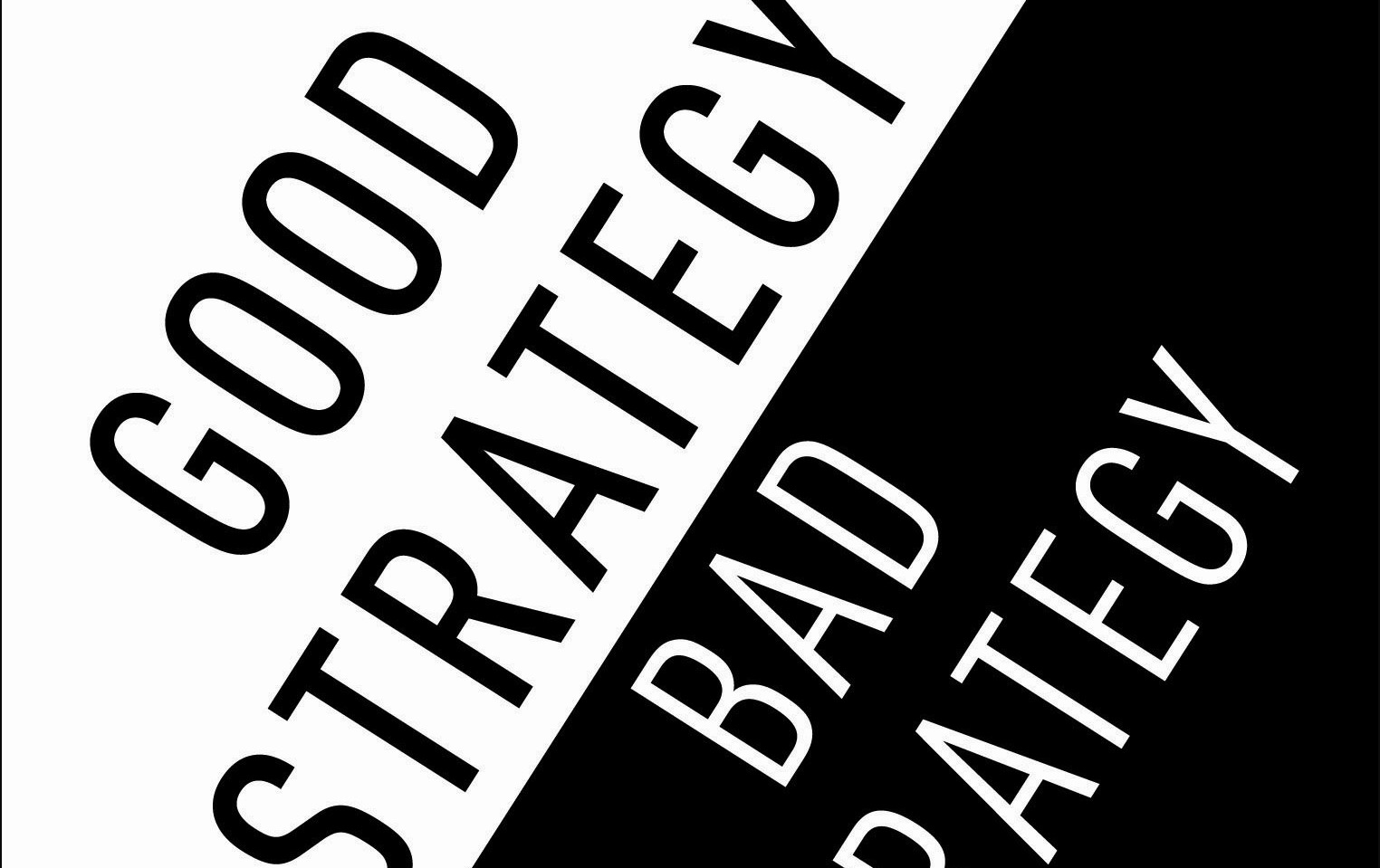Summary of Good Strategy/Bad Strategy
12 minutes read | 2466 words by Ruben BerenguelIn the midst of chaos, there is also opportunity.
Sun Tzu

This is a haphazard summary/coalescing of the notes I compiled during my reading Good Strategy/Bad Strategy, one of the best books I have read this year. Also one of the best books I have read about strategy ever.
What is strategy?
In the past decades the word strategy has been polluting other concepts, and losing its strength. Businesspeak (does this have two or three s?) has converted marketing into marketing strategy, data processing into IT strategy, acquisitions into growth strategy. When you cut prices, you say you have a low price strategy.
Strategy is thus a very elusive term. The definition (a bit hidden) Rumelt gives in the book is a decent start:
The term strategy should mean a cohesive response to an important challenge.
There is an alternative, mentioned at the end of the book. About how the author considers he started to work strategically. While at JPL (the Jet Propulsion Laboratory), he had to:
- Learn enough about all the subsystems and their interactions,
- Hold it all in his head
- Imagine an effective configuration of all the moving pieces.
Many years ago while fixing a paper for publishing I was in a similar state, but with theorems, references and a result I wanted to prove. That didn’t feel like strategy, but I see the parallels to strategy.
Now that we have a hint of what strategy is, we can start differentiating bad strategy from good strategy. Obviously, we are more interested in the second, particularly for ourselves. The first is a good source of laughs and tears, depending on whether it’s from other companies or from our place of work.
Bad strategy
Bad strategy is not just the lack of good strategy. Like there are many kinds of bad families, there are many kinds of bad strategies. Usually, bad strategy is built on mistaken foundations, and like a doomed building, looks strong until it collapses.
For instance, some people mistake correct operational management with strategy. Closing down the least effective location of a chain is not a strategy. Strategies coordinate actions to address a specific challenge.
Another whole set of mistakes has been driven by charismatic leadership being converted into a formula:
- The leader develops/has a vision,
- Inspires people to sacrifice (or change) benefiting the organisation,
- Empowers people to accomplish this vision.
This kind of vision-led leadership and strategy work gave rise to a dull template-style of strategy planning. You fill the templates with:
- Vision,
- Mission,
- Values,
- Strategies.
This was adopted by corporations, universities, the government, anybody willing to pay a consultant. I’m pretty sure you have been in a place where strategy is defined like this.

Template strategy leads directly to BS (I may mean bad strategy with this acronym). One size fits all substitutes the hard work of analysing the situation, finding the obstacles and creating coordinated action. Filling a template is easy, staring into the abyss and figuring out how to descend is not.
Bad strategy in general focuses too much on goals, but is short on policies or actions. In many cases, it assumes you only need goals, and that just by having a goal you will figure out how to achieve it. It will also put forward “strategic objectives” that are incoherent or impracticable.
All bad strategies share one or two of the following indicators, although there could be more (if this happens, run for your life):
- Fluff: buzzword bingo. Grand looking words, making up strategic concepts and arguments. It will use complex-looking concepts to create the illusion of high-level thinking. But it is an illusion. I like one example from the book, for a retail bank: Our fundamental strategy is one of customer-centric intermediation. I.e., being a bank.
- Failure to face the challenge: It does not define (or face) the strategic challenge. If you don’t know what you are against, how do you know how close or far you are?
- Mistaking goals for strategy: statements of desire instead of plans for overcoming obstacles.
- Bad strategic objectives: a strategic objective is set by a leader towards an end. Strategic objectives are bad when they fail to address critical issues, or when they are impracticable.
The effects of bad strategies can be seen in a common complaint from leaders, that of a lack of execution. This happens when instead of having a strategy, you have a fluffy set of goals and buzzwords that don’t define the challenge. They just set goals, but strategy is founded in action, and goals have no actions. No wonder there is no execution, there is nothing to execute.
They can also be seen when companies take conflicting actions. For instance, salespeople love to please customers with rush orders, but manufacturing prefer long uninterrupted production runs. Company policies should handle these and not encourage both separately (something that would happen if each department wanted 30% more returns this year!).
When you don’t define the actions to go from strategy and implementation, you are just going through the motions. It’s make believe strategy.
Now that we have an idea of how bad strategy looms, let’s see what strategy looks like.

Good strategy
Coherent action backed up by an argument, an effective mixture of thought and action with a basic underlying structure I call the kernel.
Rumelt argues that a good strategy always has a kernel. This is formed by 3 parts:
- Diagnosis,
- Guiding policy,
- Coherent action.
A good strategy recognises the challenge and offers a way to stand up to it.
Diagnosis
A great deal of strategy is figuring out what is going on. This will sound familiar to Wardley mappers reading this: it’s the couple of _O_s in Boyd’s OODA loop. Observe and Orient. In the strategic diagnosis, you need to classify the situation, by linking facts into patterns. Focuses attention on some issues, while actively ignoring others.
Once you have identified the challenge, you can start investigating it by analogy with similar business situations. It also defines the domain of action, setting the stage for the next step.
Guiding policies
Guiding policies are not goals or visions, nor images of desirable futures. Don’t put a picture of a Ferrari on a motivation board. Guiding policies tackle the obstacles identified in the analysis phase, by creating or drawing upon sources of advantage or strength.
Policies create advantages by resolving the uncertainty and ambiguity about what to do, specifying how to compete and how to organise. They are the backbone of your strategy.
You can create advantages by (i.e. your policies can be informed as):
- Anticipating the actions and reactions of others,
- Reducing the complexity and ambiguity in the situation,
- Exploit the leverage from concentrating effort on pivotal or decisive aspects of the situation,
- By creating coherent policies and actions.

You would call a competitive advantage interesting when you had insights into how to increase its value. More precisely, things under your control to increase its value. Of course, these are hard to find.
In OODA terms, it is D, Decide. Obviously.
Coherent action
He almost danced to the fridge, found the three least hairy things in it, put them on a plate and watched them intently for two minutes. Since they made no attempt to move within that time he called them breakfast and ate them.
Douglas Adams (So Long and Thanks for all the Fish)
Many would stop at the guiding policies, call them strategy and stop there. That is wrong. Strategy is about action, doing. It does not need to address all actions required, but needs to give enough clarity about actions to guide towards a conclusion.
Yeah, it’s the A, Act.
In general, the required actions are not mysterious. What makes the action part hard to execute is the pain avoidance of everybody at the company. The hope that a stroke of genius will solve several conflicting objectives in one stroke makes looking for coherence too much work. Why bother when you can feel lucky today?
When acting, you need to draw on your strengths. A coherent strategy, one coordinating policies and actions creates strength through coherence. I’ve used this word several times, and it’s easier to know what it is not: most companies follow multiple unconnected or conflicting objectives. Coherence removes these: a common objective is the goal here.
As for creating new strengths, you can do so by subtle shifts in viewpoint. By reframing the situation you can find advantages and weaknesses where there were none.

Sources of power
Rumelt identifies several sources of power:
- Leverage
- Proximate objectives
- Chain-link systems
- Design
- Advantage
- Focus
- Dynamics
- Growth
- Inertia/Entropy
Leverage: it is based on anticipation. Considering the habits, preferences and policies of others. Identifying inertias, identifying constraints on change. As this is defined, Wardley maps should be a perfect source to identify leverage points.
Proximate objectives: one of the most effective tools. Objectives that are close enough at hand to be feasible. The more uncertain and dynamic the situation, the closer the objectives need to be. Note that making an objective (proximate or not) a priority assumes other things will be taken care of. If they are not taken care of (automatically or effortlessly, and can be derailed easily), maybe you have chosen the wrong priorities.
Chain-link systems: these are synergies incarnate. When you are in charge of one link, there is no point in investing resources in improving your link if others do not. The quality of the output would not be affected by it, and costs would increase, your boss wouldn’t be thrilled by this. Fixing or establishing a chain-link system needs direct leadership and design, but once established they are very hard to replicate or beat. Think of Wal-Mart’s logistic setup, or Apple’s complete system integration.
Before Wal-Mart, it was assumed that a discount store could only work in a city with a population of at least 100k. Wal-Mart redefined this. By creating a tight-knit logistic system, they converted a regional set of stores serving one or several small towns into a “distributed store” serving millions of people. Crushing their competition during the process.
Design: strength points need to be designed. Winging it is not a strategy, a strategy is designed. Given a challenge, you should design a novel response. If, as a leader, you are given a PowerPoint with 4 options, you are not doing this properly.
Creating strategy is more like designing aircraft than deciding which forklift to buy or how to build a factory.
Advantage: you should use your relative advantages to make your competition have out of proportion costs, making competing with you hard. Competitors should not be able to replicate the resources needed for a competitive advantage. You need an isolating mechanism (a moat): patents, know-how, properties. No-one has advantages everywhere: you need to press where you do. An advantage is the gap between the buyer value and the cost from creating the product. Improving this gap should be your source of strength.
Sadly, in many cases management assumes improvement is a natural process, or can easily be developed by pressure or incentives. This is wrong, and usually caused by expecting some form of a free ride. Catching somebody else’s competitive advantage, or just expecting some magical insight.
Focus: choosing one path and ignoring others is having a strategy. Good strategies are corner solutions, finding focus over compromise. One simple example is attacking a very specific market segment, exploiting the value there.
Dynamics: you need to find the high ground. Set your troops and win the battle. Just half-kidding, unless you grab hold of a time machine and want to contest Hannibal. You can create your business high ground by innovation. You can also exploit waves of change. Waves of change are a constant in business (and life).
It is hard to show your skill as a sailor when there is no wind.
When asked after the fact, most executives know that the formula for success (the particular case highlighted in the book is for the electronics industry in the late 90s) was to take a good position quickly when a window of opportunity opened, and profit from it. But when checking their current strategy you find that very rarely it is the current strategy of the companies.

Waves of change are usually marked by:
- Increases of fixed costs (like, a resource becoming suddenly scarce),
- Deregulation (like the airline industry in the US in the mid 70s)
During waves of change you can exploit predictable biases, like most companies not assuming the expected pattern of peak and decline, or assuming that in a new niche eventually a battle of large companies will happen.
Another bias is that during waves of change the standard advice from consultants and gurus will be to copy what large current market leaders are doing. But this worked for the result of the previous wave. Don’t do that. Focus instead on attractor states, clear models of how the industry should work. This offers a hidden backbone of structure to the industry, one that eventually materialises. An example would be the dumb pipes model for Internet traffic. It was a natural development (an attractor state), and companies that went against this grain are long gone.
You must be wary of incumbents during waves of change. Their response will be to resist and fight against the wave. If you commit too early to changing your approach, the inertia of the incumbent can play for or against you. Use a bit of market judo here.
Growth: Growth in a commodity (cement, aluminium, PET) is an industry phenomenon. With no competitive advantage, once growth stops, profits stop. To improve growth, you need to identify your limiting factors. Determine those that can be fixed and those that are unfixable. The unfixable factors will set your growth ceiling.
Inertia/Entropy: An organisation is always fighting against entropy. There are 3 kinds of organisational inertia:
- Routine: can be fixed by upper management
- Cultural: can be fixed by simplification
- By proxy: requires stopping hanging onto old profit centres and move with the times.
Inertia is one of the hardest problems a company can have.
Conclusion
This has been one of the most interesting books I have read this year. I would recommend it as reading material for anyone at any level that is vaguely close to product decisions, market or leadership.
You should be aware though is that is has been a very hard book to synthesise. I had dozens of highlights collected from the book and converting them into a summary has been very hard. This makes me think this is a book that needs more than one reading (during the writing of this I re-read many pieces). Just keep this in mind when you go through it.
 5
5